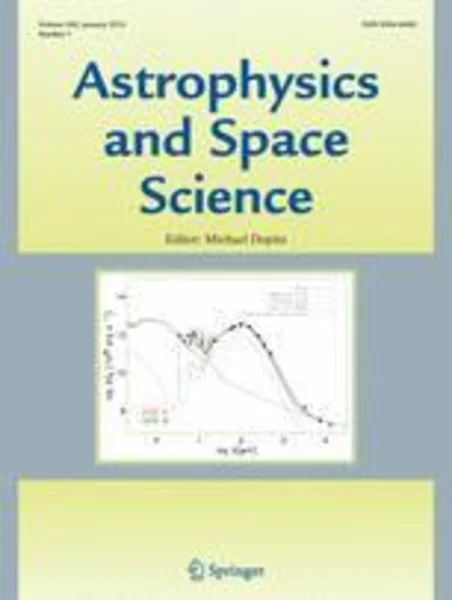-
global spectral energy distributions of the large magellanic cloud with interstellar dust
جزئیات بیشتر مقاله- تاریخ ارائه: 1392/07/24
- تاریخ انتشار در تی پی بین: 1392/07/24
- تعداد بازدید: 981
- تعداد پرسش و پاسخ ها: 0
- شماره تماس دبیرخانه رویداد: -
the effects of dust on infrared emission vary among galaxies of different morphological types. we investigated integrated spectral energy distributions (seds) in infrared and submillimeter/millimeter emissions from the large magellanic cloud (lmc) based on observations from the herschel space observatory (hso) and near- to mid-infrared observations from the spitzer space telescope (sst). we also used iras and wmap observations to constrain the seds and present the results of radiative transfer calculations using the spectrophotometric galaxy model. we explain the observations by using dust models with different grain size distributions in the interstellar medium of the lmc, noting that the lmc has undergone processes that differ from those in the milky way. we determined a spectral index and a normalization factor in the range of −3.5 to −3.45 with grain radii in the range of 1 nm–300 nm for the silicate grain and 2 nm–1 μm for the graphite grain. the best fit to the observed sed was obtained with a spectral index of −3.47, similar to the value derived by piovan et al. (mon. not. r. astron. soc. 366(3):923, 2006a). the grain size distribution is described using a power law but with a break that is introduced below a b , where a larger exponent is used. changing the graphite grain size distribution significantly changed the sed pattern within the observational uncertainties. based on the sed fits to the observations from submillimeter wavelengths to infrared radiation from the lmc using grasil (silva et al., astrophys. j. 509(1):103,1998), we obtained a reasonable set of parameter values in chemical and geometric space together with the grain size distributions (weingartner and draine, astrophys. j. 548(1):296, 2001) and a modified mrn model with the lmc extinction curve (piovan et al., mon. not. r. astron. soc. 366(3):923, 2006a). for a given set of parameters including the disc scale height, synthesis of the starlight spectrum, optical depth, escape time scale, dust model, and star formation efficiency, the adopted dust-to-gas ratio for modeling the observed seds, ∼1/300 (from the literature) yields a reasonable fit to the observed seds and similar results with the metallicity of the lmc as those reported in russell and bessell (astrophys. j. suppl. ser. 70:865, 1989). the dust-to-gas ratios that are given as the metallicity caused the variation in the model fits. the difference mainly appears at the wavelengths near 100 μm.
مقالات جدیدترین رویدادها
-
استفاده از تحلیل اهمیت-عملکرد در ارائه الگوی مدیریت خلاقیت سازمانی و ارائه راهکار جهت بهبود
-
بررسی تاثیر ارزش وجوه نقد مازاد بر ساختار سرمایه شرکت های پذیرفته شده در بورس اوراق بهادار تهران
-
بررسی تأثیر سطح افشای ریسک بر قرارداد بدهی شرکت های پذیرفته شده در بورس اوراق بهادار تهران
-
بررسی تأثیر رتبه بندی اعتباری مبتنی بر مدل امتیاز بازار نوظهور بر نقد شوندگی سهام با تأکید بر خصوصی سازی شرکت ها
-
تأثیر آمیخته بازاریابی پوشاک ایرانی بر تصویر ذهنی مشتری پوشاک ایرانی (هاکوپیان)
-
بررسی تحلیلی سیره عقلا به انضمام چگونگی کاشفیت از حکم آن و ثمرات
-
شبیه سازی معتبر رفتار قابهای عرضی در پلهای فولادی خمیده
-
ارزیابی عملکرد لرزه ای میراگرهای تسلیمی t-adas در قاب های فولادی بلند مرتبه تحت تحریکات حوزه نزدیک گسل
-
بهینه یابی سازه های قاب خمشی فولادی با استفاده از الگوریتم ژنتیک تعمیم یافته تحت قیود قابلیت اعتماد
-
تاثیرات سیستم اتوماسیون اداری و بایگانی الکترونیک بر عملکرد سازمان
مقالات جدیدترین ژورنال ها
-
مدیریت و بررسی افسردگی دانش آموزان دختر مقطع متوسطه دوم در دروان کرونا در شهرستان دزفول
-
مدیریت و بررسی خرد سیاسی در اندیشه ی فردوسی در ادب ایران
-
واکاوی و مدیریت توصیفی قلمدان(جاکلیدی)ضریح در موزه آستان قدس رضوی
-
بررسی تاثیر خلاقیت، دانش و انگیزه کارکنان بر پیشنهادات نوآورانه کارکنان ( مورد مطالعه: هتل های 3 و 4 ستاره استان کرمان)
-
بررسی تاثیر کیفیت سیستم های اطلاعاتی بر تصمیم گیری موفق در شرکتهای تولیدی استان اصفهان (مورد مطالعه: مدیران شرکتهای تولیدی استان اصفهان)
-
تاثیر اندوه مقایسه بر سایش اجتماعی با میانجی گری حسادت خاموش
-
بررسی نقش های بیولوژیک و اجتماعی - اقتصادی خرس قهوه ای (ursus arctos syriacus) در توده های جنگلی شمال ایران
-
بررسی ابعاد موفقیت پیاده سازی سیستم های هوش تجاری در شرکت های تولیدی ( مطالعه موردی: شرکت تولیدی سیمان )
-
بررسی و شناخت ماهیت مالیات و اقسام آن
-
the role of environmental graphic in the identification of urban public spaces




سوال خود را در مورد این مقاله مطرح نمایید :